
Hamamelidaceae, commonly referred to as the witch-hazel family, is a family of flowering plants in the order Saxifragales. The clade consists of shrubs and small trees positioned within the woody clade of the core Saxifragales. An earlier system, the Cronquist system, recognized Hamamelidaceae in the Hamamelidales order.

Delonix regia is a species of flowering plant in the bean family Fabaceae, subfamily Caesalpinioideae native to Madagascar. It is noted for its fern-like leaves and flamboyant display of orange-red flowers over summer. In many tropical parts of the world it is grown as an ornamental tree and in English it is given the name royal poinciana, flamboyant, phoenix flower, flame of the forest, or flame tree.

Choy sum is a leafy vegetable commonly used in Chinese cuisine. It is a member of the genus Brassica of the mustard family, Brassicaceae. Choy sum is a transliteration of the Cantonese name, which can be literally translated as "heart of the vegetable". It is also known as Chinese flowering cabbage.
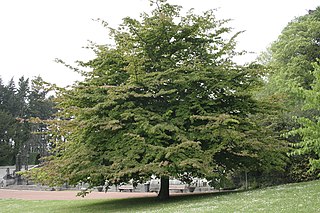
Parrotia persica, the Persian ironwood, is a deciduous tree in the family Hamamelidaceae, closely related to the witch-hazel genus Hamamelis. It is native to Iran's Caspian region and Iranian Azerbaijan. It is endemic in the Alborz mountains, where it is found mainly in Golestan National Park.

Cabot's tragopan is a pheasant found in south-east China. The common and scientific names of this large bird both commemorate the ornithologist Samuel Cabot III. Other common names include the Chinese tragopan and the yellow-bellied tragopan. The population is divided into two subspecies, of which the dominant subspecies is found in the provinces of Fujian, Jiangxi, Zhejiang, and Guangdong, and T. c. guangxiensis is confined to northeastern Guangxi and southern Hunan. The IUCN has assessed it as being a "vulnerable species".

Prasophyllum, commonly known as leek orchids, is a genus of about 140 species of flowering plants in the orchid family, Orchidaceae and is found in Australia and New Zealand. The Australian species are found in all states but have not been recorded in the Northern Territory. The common name arises from their having a hollow, leek- or onion-like leaf. Some species only flower after summer fires and have flowers similar to those of Xanthorrhoea which flower at the same time, suggesting that they employ the same pollinating insects. Leek orchids are similar to those in the genus Genoplesium except that the free part of the leaf is cylindrical and the labellum has a solid connection to the column. They range in size from the little laughing leek orchid at about 15 cm (6 in) to the king leek orchid which grows up to 2 m (80 in) tall.
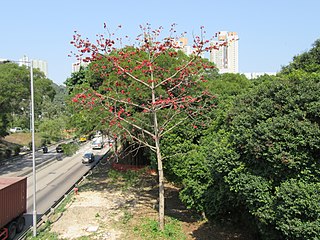
Bombax ceiba, like other trees of the genus Bombax, is commonly known as cotton tree. More specifically, it is sometimes known as Malabar silk-cotton tree; red silk-cotton; red cotton tree; or ambiguously as silk-cotton or kapok, both of which may also refer to Ceiba pentandra.
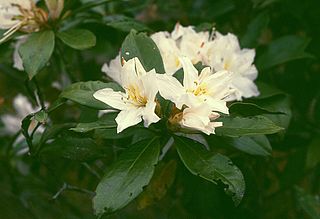
Rhododendron moulmainense, Westland's rhododendron, is a species of Rhododendron native to southern China, Myanmar, Malaysia, Thailand, and Vietnam.

Pinus massoniana is a species of pine, native to Taiwan, a wide area of central and southern China, and northern Vietnam.

Rhodoleia is a genus of plants in the family Hamamelidaceae. Together with its sister genus Exbucklandia, Rhodoleia forms the sister clade to the other 25 genera of Hamamelidaceae. Flowers of Rhodoleia are bird-pollinated. Nectar-foraging birds including Japanese white-eyes and fork-tailed sunbirds, avidly visit the flowers, which they also pollinate in the process.

Exbucklandia is a genus of flowering plants in the family Hamamelidaceae. They are medium to large trees whose natural range is from eastern India through southern China and southward through the Malay Peninsula. In India and China, they are widely cultivated for their impressive foliage and valuable lumber. A few have been grown in the southernmost parts of the United States. To speakers of English, Exbucklandia is generally known as the Pipli tree, from the Bengali name for the species Exbucklandia populnea.

Oreocallis is a South American plant genus in the family Proteaceae. There is only one species, Oreocallis grandiflora, which is native to mountainous regions in Peru and Ecuador.

Dillenia suffruticosa, also known as simpoh air, simpor, or CB leaf, is a species of Dillenia found in tropical South East Asia in secondary forest and swampy ground. It is a highly invasive weed in Sri Lanka.
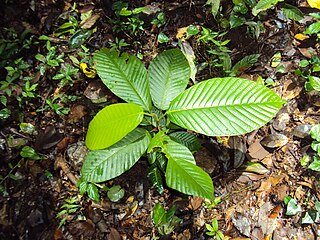
Dipterocarpus bourdillonii is a species of large tree in the family Dipterocarpaceae endemic to the Western Ghats principally in the state of Kerala in India. It is a Critically Endangered species according to the IUCN Red List of Threatened Species. It is a characteristic tree of the low-elevation tropical wet evergreen rainforests in the Western Ghats.

Iris speculatrix is a beardless iris in the genus Iris, in the subgenus Limniris and in the series Chinenses of the genus. It is a rhizomatous herbaceous perennial, from Asia, found in China, Hong Kong and Taiwan. It has dark green, evergreen leaves, long slender stem and flowers in various blue shades, from violet, lilac, lavender, to light blue.
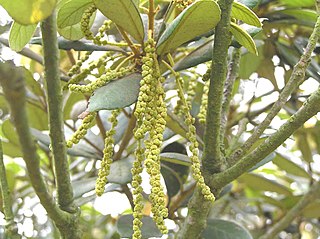
Quercus championii is an uncommon species of tree in the family Fagaceae. It has been found only in southern China, in the Provinces of Fujian, Guangdong, Guangxi, Hainan, Taiwan, and Yunnan. It is placed in subgenus Cerris, section Cyclobalanopsis.

Brexia is a plant genus assigned to the Celastraceae. It is a dense evergreen shrub or small tree of usually around 5 m high, with alternately set, simple, leathery leaves with a short leaf stem and lanceolate to inverted egg-shaped leaf blades. The pentamerous flowers occur in cymes. The petals are greenish white, the stamens are alternating with wide, incised staminodes. The superior ovary develops in a long-ribbed fruit. Brexia naturally grows on the coast of East Africa, on Madagascar, the Comoros and Seychelles. Opinions differ about the number of species in Brexia. Sometimes the genus is regarded monotypic, B. madagascariensis being a species with a large variability, but other authors distinguish as many as twelve species. Common names for B. madagascariensis include jobiapototra, tsimiranjana, tsivavena, vahilava, voalava, voankatanana, voantalanina, voatalanina and votalanina, and mfukufuku (Swahili), mfurugudu and bwa kato (Seychelles).
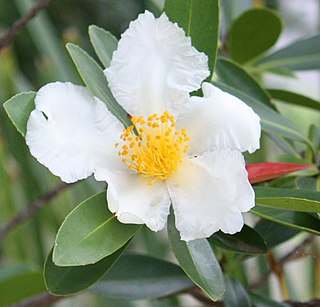
Polyspora axillaris is a species of evergreen trees or shrubs that can grow up to 9 m tall. It has been given the name "Fried Egg Plant" for its white and yellow flower. P. axillaris is found in Southern China, including Hong Kong and Hainan. Is also grows in the wild in Taiwan and Vietnam, and is a garden tree all over the world.

Aporosa octandra is a species of plant in the family Phyllanthaceae found from Queensland and New Guinea to Indonesia, Zhōngguó/China and India. It is a highly variable plant with 4 named varieties. Its wood is used in construction and to make implements, its fruit is edible. The Karbi people of Assam use the plant for dyeing, textile colours have quite some significance in their culture.

Schima superba is a species of flowering plant in the tea family Theaceae, native to subtropical areas of Vietnam, southern China, Hainan, Taiwan, and the Ryukyu Islands. With Pinus massoniana it often dominates forests from 100 to 800 m in elevation. It is used as a street tree in a number of southern Chinese cities.





















